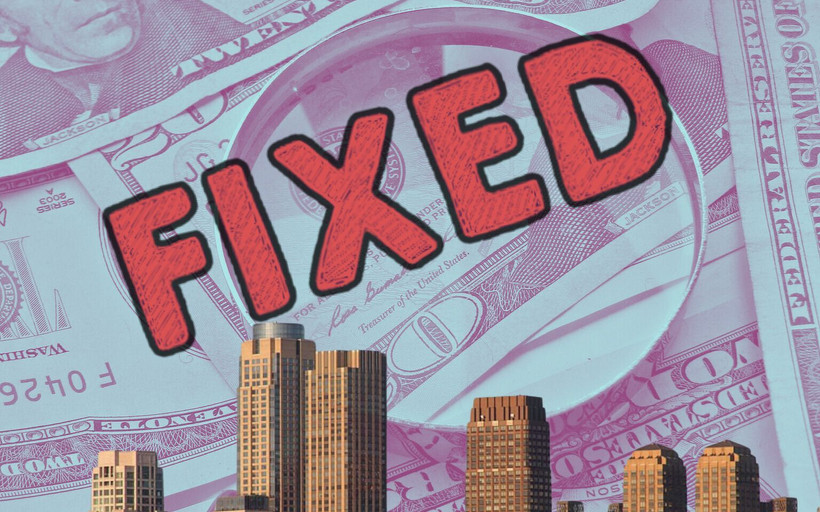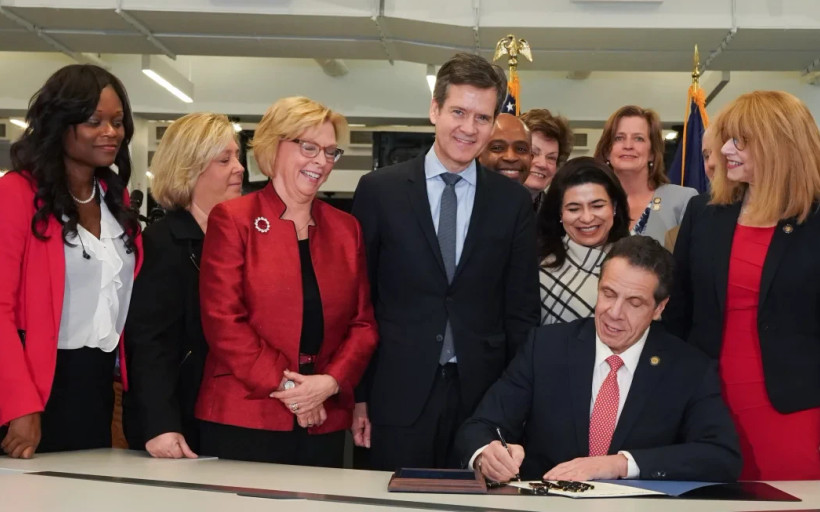The Cap-and-Trade Fight Comes to New York
While the state climate council weighs a “cap-and-invest” program, environmental justice groups are pressing for new taxes on the rich and the polluters.

IT WAS A DEFINING MOMENT in US climate politics. In 2009, with Barack Obama freshly in the White House and Democratic majorities in both chambers, Congress came close to passing a sweeping bill that would have set an economy-wide cap on carbon emissions. But the bill failed, and “cap and trade,” as it’s known, became for many a third rail of climate policy.
Still, the idea remained popular among climate wonks. California embraced it statewide in 2013, with fiercely contested results. For years, California remained the only state to adopt the policy. Then, in 2020, Oregon took up its own version of cap and trade — through executive action, after Republicans walked out on attempts to pass it through the legislature. And last year, Washington passed a plan of its own after several failed attempts at carbon pricing, under the label “cap and invest.”
New York could be next. As the state’s Climate Action Council wraps up deliberations over its plan for implementing the climate law, it is weighing a proposal that would set an economy-wide cap on carbon emissions, in line with those already set by the climate law. The policy would require emitters to buy “allowances” for every ton of pollution up to that cap, with the proceeds going toward clean energy, electrification of buildings and transportation, and other initiatives needed to bring emissions down to zero.
The proposal is outlined in a 10-page draft chapter of the final scoping plan, which the council is due to vote on and publish by the end of the year. The updated chapter on “Economy-Wide Strategies” — which is not yet public, but has been reviewed by New York Focus — weighs the cap-and-invest option alongside a carbon tax, which would also put a price on emissions. It comes down on the side of cap and invest, arguing that only such a strategy would provide certainty that the law’s emissions targets are actually being met.
If the council votes to endorse cap and invest, it would still only serve as a recommendation — not binding policy. But the endorsement would carry a lot of weight. And if Governor Kathy Hochul runs with it, officials say her administration could implement it directly through executive action, bypassing the legislative process.
Such a move would provide at least a partial answer to a question that has dogged New York climate politics for years: Who’s going to pay for the upfront investments needed to go green? But some environmental justice advocates are wary, including council member Raya Salter, who told the group she was “completely unconvinced” the proposal would live up to the equity requirements of the climate law.
NY Renews — the broad coalition of environmental, community, and labor groups that led the campaign to pass the climate law in 2019 — earlier this month unveiled a package of bills providing their own answer to the climate funding dilemma. Several of those bills aim to raise revenue, principally by taxing the rich and the biggest polluters, while another would create a dedicated Climate and Community Protection Fund to spend it.
The state’s own analysis found last year that decarbonizing the economy will take roughly $15 billion a year in upfront spending by 2030, though the state should more than recoup that investment through the economic and public health benefits of slashing pollution. Analysts did not determine how to split up those costs — between the state or federal government, private businesses, homeowners, and renters. The federal Inflation Reduction Act has since filled in one piece of the puzzle, but the state’s share remains largely undecided.
“We all know the big assignment: We have to reduce our dependence on oil and gas,” said Senate finance committee chair Liz Krueger, “and we have to figure out how to pay for everything.” Citing the expert panel’s recommendations as a likely swing factor, she added, “I am optimistic that we’re going to see more action in Albany this year than in previous years.”
NY Renews’s package aims to raise a total of $10 billion per year. The cap-and-invest approach does not yet have a dollar amount attached to it, since the total revenue would depend on the price of allowances the state sells at auction, which in turn would need to be set through a complex regulatory process.
‘The Best in the World’
New York already participates in what was actually the United States’ first cap-and-trade system: the Regional Greenhouse Gas Initiative, or RGGI, which took effect in 2009. The program is less comprehensive than California’s — power plants are the only polluters it covers — but broader, now spanning 12 northeast states home to a fifth of the US population. The program raised $221 million for New York last year.
Both RGGI and the California policy have faced criticism over their role in reducing pollution: Overall emissions in both cases have declined, but analysts dispute that cap and trade has driven that trend. Meanwhile, concerns about equity have only become more pronounced.
“Cap and trade is one of those things that looks good on paper, but I have yet to see it successfully done,” said Mijin Cha, associate professor of urban and environmental policy at Occidental College. “Whenever you let polluters decide where they’re going to reduce pollution, that introduces the almost certain possibility of inequity.”
A recent University of California study of cap and trade found that disadvantaged communities have seen less significant reductions in pollution than more privileged ones, with pollution actually increasing in some areas in the first years after the policy took effect.
RGGI, similarly, has done little to reduce local pollution in the worst-affected areas, a flaw that some of its supporters acknowledge. Anne Reynolds, executive director of the Alliance for Clean Energy NY and a member of the Climate Action Council, says RGGI has not been perfect, but remains the right template to build on.
“I think we have the possibility of designing a cap-and-invest program that would be the best in the world,” she told the council at its last meeting.
Such a plan would simultaneously address two of the core questions New York’s climate law continues to raise, Reynolds told New York Focus: “Are you really going to meet the limits? And how’s New York going to pay for them? To me, you need a cap-and-invest program — or, maybe more accurately, you need an economy-wide price signal — in order to answer both of those questions.”
Reynolds stressed that the working group behind the new cap-and-invest proposal has taken pains to improve on existing models, specifically regarding disadvantaged communities.
The main proposal to avoid creating pollution “hotspots” is to restrict polluters in disadvantaged communities from trading their emissions allowances with those elsewhere. The draft chapter also acknowledges that use of offsets would need to be “strictly limited or even prohibited,” closing a loophole that has undermined existing cap-and-trade systems.
On the investment side, the draft underlines that at least 35 percent of spending from the program would go towards disadvantaged communities, as required by the climate law. And it suggests earmarking some of the program’s revenue for household rebates or “dividends,” to avoid burdening low-income New Yorkers with any short-term energy price hikes that might result from putting a price on carbon.
“My support for [cap and invest] is predicated on it having those safeguards,” Reynolds said.
Implementation Hurdles
Proponents of the cap-and-invest plan argue that it has another advantage over the alternatives: It could be implemented directly by the Hochul administration, without having to go through the budget process. This is how New York implemented RGGI (unlike most other states in the program, which went through legislation).
That move was challenged in court by a power plant operator, and the state is likely to face another round of lawsuits if it advances an economy-wide program without legislation, said Michael Gerrard, faculty director of the Sabin Center for Climate Change Law at Columbia University.
Utilities, which are among the biggest targets of the New York proposal, have yet to weigh in on it publicly. Reached by New York Focus, National Grid said it was still reviewing the proposal, and Con Edison provided a general statement on its commitment to climate action without commenting on cap and invest specifically. In Oregon, gas utilities have joined business groups in seeking to overturn the carbon cap program.
Gavin Donohue, president of the power industry trade group Independent Power Producers of New York (IPPNY), told New York Focus that the group supports putting an economy-wide price on carbon, but that “the details matter” and have not yet been worked out to his satisfaction. Those include addressing the risk of “leakage” — or carbon-intensive industries fleeing to less-regulated states — and avoiding redundancy with RGGI, as well as the state’s power to implement cap and invest through regulation.
“It’s a damn good question,” Donohue said. “I think that this is such a big deal that this legislature would have to be part of it,” but the climate law gives the state agencies “a lot of latitude in the regulatory space,” he added.
Environmental justice advocates have raised concerns about aspects of the process beyond potential court challenges. The proposal has taken shape in the final months before the state’s climate plan is due, largely behind closed doors. While the idea has been on the table since last year, key elements of the program’s design are only just beginning to come to light. Even now, with just weeks left before the council is set to vote on its final scoping plan, the relevant chapter has not been made public. (It was shared with New York Focus on the condition that it not be published.)
“There were rumblings about it, but the lack of transparency is a major problem,” said Anthony Rogers-Wright, director of environmental justice at New York Lawyers for the Public Interest and a steering committee member of NY Renews.
Proponents of cap and invest note that, even if the state were to adopt this approach, it would require a year-long rulemaking process to be finalized, giving the public an opportunity to weigh in. For Rogers-Wright, the process amounts to another way of kicking the can down the road.
“We don’t have time to continue going through bureaucratic processes,” he said. “The [climate law] put the finish line in view; we have to cross it now. … And I don’t think that this first step is in alignment with the urgency.”
Critics also note that long, technical rulemaking processes also offer industry lobbyists an opening to extract concessions behind the scenes.
Could New York find a way to thread the needle between market-based solutions and the justice imperatives embedded in its climate law? NY Renews has spent much of the past three years trying to do just that: Its flagship bill last year was essentially a carbon tax, designed to fund a just transition off of fossil fuels. But the coalition moved away from that strategy after the bill failed to advance — and sparked heated controversy within its own ranks.
The variety of bills NY Renews is backing this year in part reflects a lack of consensus among environmental justice groups about how best to raise funds for climate. Some campaigners have even expressed tentative support for cap and invest, depending on the details, despite a preference for taxing the rich.
The cap-and-invest approach shares at least one principle with those backed by most grassroots groups: that the biggest polluters should pay to clean up the mess. It would apply that principle only to current polluters, whereas a bill like Krueger’s Climate Change Superfund Act would extend it to historical emissions, levying $30 billion over 10 years from the few dozen companies that have contributed the most to the climate crisis.
Hochul’s office has yet to endorse any of the proposals. A spokesperson said her administration would “review and engage with all relevant parties” once the final scoping plan is delivered in order to meet the state’s climate goals.
Krueger said she is not attached to any one approach, and she doesn’t see a conflict between cap and invest and the bills she has championed.
“Some people were nervous that if this was moving, some of the other proposals might not be able to move,” she said of the Superfund bill. “I don’t accept that. I take the position, everybody throw your best ideas on the table. Let’s see what we pull off and what we can’t pull off — no penalty for multiple efforts to try to go down the same road.”



